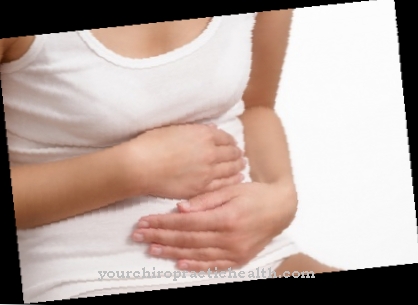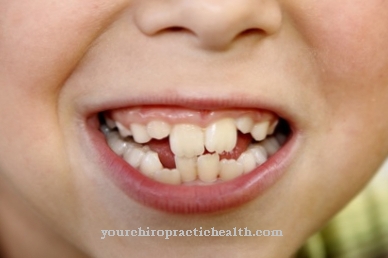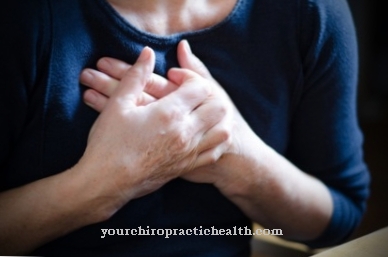Movement pain or Stress pain describe pain that occurs only as a result of movement of the corresponding part of the body. In the resting state, however, there are only very few or no symptoms. They can start from the joint or from the muscles and affect the entire musculoskeletal system.
What are movement pain?

The term movement pain is understood by doctors as pain in the musculoskeletal system that occurs as a direct result of movement. This is in direct contrast to pain at rest, where no movement is necessary to cause discomfort.
Movement pain can affect almost all parts of the musculoskeletal system and originate either in the respective joints or in the muscles. The painful complaints in the back and shoulder area are particularly common.
Many German citizens are temporarily or even chronically affected by pain from movement; Experts already speak of a "widespread disease" in this context. Depending on the cause and the level of progression, adequate therapy can under certain circumstances achieve complete freedom from pain.
causes
Movement pain is particularly common in advanced age. In many cases, the reason for this is osteoarthritis, a sign of wear and tear on the joint cartilage, which leads to the typical painful movements.
Osteoarthritis can occur in the knee or hip joints. Rheumatic inflammation of the muscles and joints in the musculoskeletal system can also be a cause of painful complaints. Injuries such as a sprain or fracture of a joint involved in the musculoskeletal system also lead to pain on the move; however, in these cases there is also pain at rest until the injury has healed.
Reduced blood flow to the legs can cause so-called ischemic pain on the move. In this context, intermittent claudication is best known.
You can find your medication here
➔ Medicines for painDiseases with this symptom
- arthrosis
- Obesity
- Neuropathy
- Metabolic disorder
- Diabetes mellitus
- Muscular dystrophy
- Guillain-Barré Syndrome
- Gallstones
- arteriosclerosis
- rheumatism
- Smoker's leg
- thrombosis
- Arterial Disease
- Raynaud's Syndrome
- Shoulder arm syndrome
- osteoporosis
- Carpal tunnel syndrome
- disc prolapse
Diagnosis & course
Movement pain is only one cause of a disease or injury and can be diagnosed very easily by itself. The attending physician attaches particular importance to determining the cause that leads to the symptoms in the individual case.
In addition to mobility and muscle function tests, imaging measures such as an X-ray examination or computed tomography can take place. These provide information about the condition of the bones and joints. In this way, for example, any age-related wear and tear or injuries can be identified.
Movement pain that occurs as a result of an injury usually subsides with appropriate treatment. If osteoarthritis or circulatory disorders are the cause, the symptoms worsen if left untreated and significantly limit the person's ability to move.
Complications
Movement pain only occurs when the corresponding parts of the body are stressed; one also speaks of stress pain. In the resting state, those affected often have no or very little pain. A muscle can cause this, a nerve is pinched, or the pain is caused in a joint. In medicine, movement pain means that the musculoskeletal system hurts as a result of movement. All parts of the musculoskeletal system can be affected, but mostly the shoulder and back are affected. In the meantime, many people are even chronically affected, and doctors are already speaking of a true "widespread disease".
Movement pain naturally increases in old age, osteoarthritis is to blame. Osteoarthritis is a wear and tear on the joints. Osteoarthritis is often found in the hip or knee joints, while rheumatic inflammation can affect the entire musculoskeletal system. Of course, fractures or sprains also lead to this pain. Movement pain indicates another illness or injury, but pain is not an independent illness.
The pain indicates an illness or injury, and a diagnosis can then be made quickly using an X-ray examination or computed tomography. Movement pain always occurs when the joints are worn out or when there is an injury. If osteoarthritis has been diagnosed and it is not treated, the ability to move will be considerably restricted in the course of the disease. Treatment is always based on the diagnosis; in the event of a fracture or sprain, the affected part of the body must be immobilized.
When should you go to the doctor?
Movement pain hardly ever occurs at rest, but actually only when moving. Movement pains affect the muscles, a joint, a part of the body, but also the trunk and there in particular the shoulders and back. Movement pain is very common. They are temporary or chronic. In the case of movement-dependent pain that has only recently appeared, you can first wait to see whether it will subside by itself.
This is to be expected above all in the case of pain caused by excessive strain or exercise. A visit to the doctor is only indicated if there is no improvement after a few days. But there are also promising treatment methods for chronic movement pain. Occasionally, chronic movement pain can even go away completely. So it is definitely worth having this form of pain clarified by a doctor instead of accepting it.
In the case of movement pain, it should always be remembered that this may be associated with an underlying disease that requires treatment, for example osteoarthritis, rheumatism or poor blood circulation. The first point of contact for movement pain is the general practitioner who, based on his or her anamnesis, refers the patient to other specialists such as orthopedists, rheumatologists, cardiologists, angiologists or neurologists for further clarification.
Doctors & therapists in your area
Treatment & Therapy
How exactly movement pain is treated in each individual case depends on the cause of the symptoms. If there is an injury such as a fracture or sprain, the affected joint is immobilized until the pain subsides and the temporary damage has healed.
In the case of severe pain, temporary drug treatment can also take place. Medicines can be used as well as therapy if a rheumatic disease, muscle tension or osteoarthritis is present. Depending on the cause, the treating doctor may prescribe anti-inflammatory drugs or muscle relaxants (drugs to relax the muscles). Physiotherapy therapy can also help to keep muscles and joints more flexible.
In contrast to an acute injury, the symptoms cannot be permanently eliminated, but only alleviated. Particularly if the pain from movement is already chronic, there may already be permanent damage to the musculoskeletal system. As a last measure, especially in the case of joint damage, only a surgical procedure, in which the affected joint is replaced by an artificial one, can help. Such an operation takes place especially when the pain and restricted mobility are already very severe.
Outlook & forecast
Whether the pain during movement will go away on its own or whether it needs to be treated depends very much on its cause and therefore cannot be universally predicted. In most cases, pain from movement occurs when the body has been stressed too much. This can be done through heavy work or vigorous exercise. In these cases, the pain from movement will subside on its own and will not lead to any further complications. The body should be spared, however, as otherwise inflammation or tears in the muscles can occur.
Movement pain is a common symptom, especially in old age. It restricts the life of the person concerned relatively severely, so that the patient can rely on the help of carers. As a result, the quality of life deteriorates.
Movement pain can also mean that the patient can no longer go about his or her work if it is associated with physical strain. In many cases, pain therapy or physiotherapy can be used to treat pain on the move. A healthy lifestyle and the inclusion of light sporting activity also have a positive effect on movement pain and can even prevent it. If the pain is severe, bandages can be used to accompany the movements and relieve the body.
You can find your medication here
➔ Medicines for painprevention
Movement pain that occurs as a result of osteoarthritis, muscle tension or rheumatic diseases can to a certain extent be prevented by a healthy lifestyle.
This particularly includes avoiding obesity and regular exercise and sport, as this strengthens muscles and joints. Routine medical examinations - especially at an advanced age - can help identify the first signs of illness at an early stage and actively prevent it from getting worse. Even if movement pain occurs frequently, it is advisable to see a doctor and have the causes clarified.
You can do that yourself
Movement pain often indicates problems with the muscles. Taking preventive action can anticipate such pain. When feeding, you should pay attention to a good magnesium balance, which prevents cramps. A lot of movement keeps the muscles flexible and makes them resilient. For this reason, adequate warm-up training should be ensured, especially during sporting activities. In addition, the muscles should not be overwhelmed and slowly get used to new loads.
In acute pain, the corresponding muscle groups should be spared. Sudden pain in movement during exercise can be a sign of a muscle injury. In this case, training should be stopped immediately to avoid further damage to the affected muscle. The corresponding place should be refrigerated and stored high.
In the case of chronic pain, regular heat treatment can provide relief. Heat patches or heaters are common aids for chronic painful movements. The choice of physical activity can also affect the sore muscles. Fast-moving sports should be avoided. This includes, for example, ball games or martial arts. On the other hand, sports that evenly strain the muscles can be performed. Cycling or swimming is recommended, and running on suitable soft surfaces is also possible.
Relaxation exercises or massages of the affected areas are also recommended for the treatment of painful movements.




.jpg)








.jpg)

.jpg)
.jpg)











.jpg)